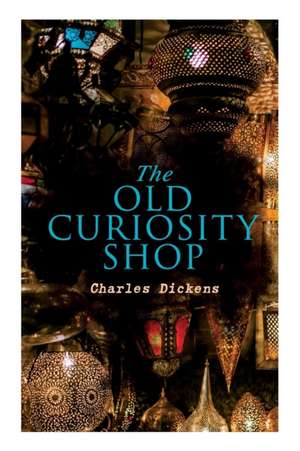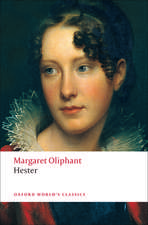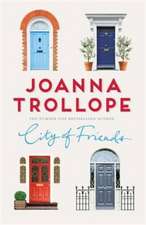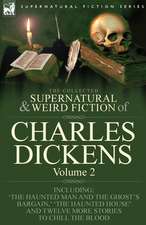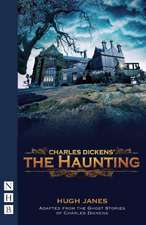The Old Curiosity Shop: Illustrated Edition
Autor Charles Dickensen Limba Engleză Paperback – 15 apr 2019 – vârsta până la 12 ani
Convinced that the old man has stored up a large and prosperous fortune for Nell, her wastrel older brother, Frederick, convinces the good-natured but easily led Dick Swiveller to help him track Nell down, so that Swiveller can marry Nell and share her supposed inheritance with Frederick. To this end, they join forces with Quilp, who knows full well that there is no fortune, but sadistically chooses to 'help' them to enjoy the misery it will inflict on all concerned. Quilp begins to try to track Nell down, but the fugitives are not easily discovered. To keep Dick Swiveller under his eye, Quilp arranges for him to be taken as a clerk by Quilp's lawyer, Mr. Brass. At the Brass firm, Dick befriends the mistreated maidservant and nicknames her 'the Marchioness'. Nell, having fallen in with a number of characters, some villainous and some kind, succeeds in leading her grandfather to safety in a far-off village (identified by Dickens as Tong, Shropshire), but this comes at a considerable cost to Nell's health.
Meanwhile, Kit, having lost his job at the curiosity shop, has found new employment with the kind Mr and Mrs Garland. Here he is contacted by a mysterious 'single gentleman' who is looking for news of Nell and her grandfather. The 'single gentleman' and Kit's mother go after them unsuccessfully, and encounter Quilp, who is also hunting for the runaways. Quilp forms a grudge against Kit and has him framed as a thief. Kit is sentenced to transportation. However, Dick Swiveller proves Kit's innocence with the help of his friend the Marchioness. Quilp is hunted down and dies trying to escape his pursuers. At the same time, a coincidence leads Mr Garland to knowledge of Nell's whereabouts, and he, Kit, and the single gentleman (who turns out to be the younger brother of Nell's grandfather) go to find her. Sadly, by the time they arrive, Nell has died as a result of her arduous journey. Her grandfather, already mentally infirm, refuses to admit she is dead and sits every day by her grave waiting for her to come back until, a few months later, he dies himself.
| Toate formatele și edițiile | Preț | Express |
|---|---|---|
| Paperback (36) | 48.50 lei 11-16 zile | +25.28 lei 6-12 zile |
| Oxford University Press – 11 dec 2008 | 48.50 lei 11-16 zile | +25.28 lei 6-12 zile |
| Real Reads – 31 mai 2012 | 50.51 lei 3-5 săpt. | +6.17 lei 6-12 zile |
| Penguin Books – 24 ian 2001 | 56.96 lei 22-33 zile | +25.48 lei 6-12 zile |
| Alma Books COMMIS – 21 feb 2024 | 59.57 lei 3-5 săpt. | +16.96 lei 6-12 zile |
| CREATESPACE – | 83.82 lei 3-5 săpt. | |
| CreateSpace Independent Publishing Platform – | 90.13 lei 3-5 săpt. | |
| CREATESPACE – | 113.17 lei 3-5 săpt. | |
| – | 140.11 lei 3-5 săpt. | |
| CREATESPACE – | 144.21 lei 3-5 săpt. | |
| CREATESPACE – | 148.80 lei 3-5 săpt. | |
| e-artnow – 15 apr 2019 | 149.67 lei 3-5 săpt. | |
| – | 172.06 lei 3-5 săpt. | |
| CREATESPACE – | 173.82 lei 3-5 săpt. | |
| – | 195.78 lei 3-5 săpt. | |
| CREATESPACE – | 204.11 lei 3-5 săpt. | |
| CreateSpace Independent Publishing Platform – | 111.44 lei 6-8 săpt. | |
| Digireads.com – 6 noi 2019 | 129.87 lei 6-8 săpt. | |
| – | 134.57 lei 6-8 săpt. | |
| – | 145.79 lei 6-8 săpt. | |
| – | 152.03 lei 6-8 săpt. | |
| – | 153.59 lei 6-8 săpt. | |
| Prince Classics – 19 iun 2019 | 153.64 lei 39-44 zile | |
| Throne Classics – 17 iul 2019 | 153.64 lei 39-44 zile | |
| – | 155.77 lei 6-8 săpt. | |
| – | 155.77 lei 6-8 săpt. | |
| – | 167.33 lei 6-8 săpt. | |
| Bottom of the Hill Publishing – 30 sep 2013 | 167.96 lei 6-8 săpt. | |
| CreateSpace Independent Publishing Platform – 29 noi 2015 | 175.75 lei 6-8 săpt. | |
| Mint Editions – oct 2020 | 190.66 lei 39-44 zile | |
| Wildside Pr – 30 apr 2008 | 231.49 lei 6-8 săpt. | |
| Simon & Brown – 28 oct 2018 | 265.34 lei 39-44 zile | |
| Simon & Brown – 14 noi 2018 | 280.33 lei 39-44 zile | |
| Delany Press – 25 oct 2007 | 314.51 lei 39-44 zile | |
| Hansebooks – 17 mai 2023 | 343.13 lei 39-44 zile | |
| Hansebooks – mar 2021 | 354.94 lei 6-8 săpt. | |
| Echo Library – 31 oct 2008 | 364.64 lei 39-44 zile | |
| Hardback (6) | 50.40 lei 3-5 săpt. | +5.81 lei 6-12 zile |
| Baker Street Press – 26 aug 2021 | 50.40 lei 3-5 săpt. | +5.81 lei 6-12 zile |
| Mint Editions – 6 oct 2020 | 201.65 lei 3-5 săpt. | |
| Throne Classics – 17 iul 2019 | 228.48 lei 39-44 zile | |
| Simon & Brown – 28 oct 2018 | 318.40 lei 39-44 zile | |
| Simon & Brown – 14 noi 2018 | 341.49 lei 39-44 zile | |
| OUP OXFORD – 12 noi 1997 | 1529.00 lei 32-37 zile |
Preț: 149.67 lei
Nou
Puncte Express: 225
Preț estimativ în valută:
28.64€ • 30.63$ • 23.88£
28.64€ • 30.63$ • 23.88£
Carte disponibilă
Livrare economică 27 martie-10 aprilie
Preluare comenzi: 021 569.72.76
Specificații
ISBN-13: 9788026892175
ISBN-10: 8026892178
Pagini: 388
Dimensiuni: 151 x 226 x 21 mm
Greutate: 0.53 kg
Editura: e-artnow
ISBN-10: 8026892178
Pagini: 388
Dimensiuni: 151 x 226 x 21 mm
Greutate: 0.53 kg
Editura: e-artnow
Descriere
Descriere de la o altă ediție sau format:
`... holding her solitary way among a crowd of wild, grotesque companions; the only pure, fresh, youthful object in the throng.' `Little Nell' cares for her grandfather in the gloomy surroundings of his curiosity shop. Reduced to poverty the pair flee London, pursued by the grotesque and vindictive Quilp. In a bizarre and shifting kaleidoscope of events and characters the story reaches its tragic climax, an ending that famously devastated the novel's earliest readers. Dickens blends naturalistic and allegorical styles to encompass both the actual blight of Victorian industrialization and textual echoes of Bunyan, the Romantic poets, Shakespeare, pantomine and Jacobean tragedy. Contrasting youth and old age, beauty and deformity, innocence and cynicism, The Old Curiosity Shop is a compelling mixture of humour and brooding meance. This edition uses the Clarendon text, the definitive edition of the novels of Charles Dickens, and includes the original illustrations. ABOUT THE SERIES: For over 100 years Oxford World's Classics has made available the widest range of literature from around the globe. Each affordable volume reflects Oxford's commitment to scholarship, providing the most accurate text plus a wealth of other valuable features, including expert introductions by leading authorities, helpful notes to clarify the text, up-to-date bibliographies for further study, and much more.
`... holding her solitary way among a crowd of wild, grotesque companions; the only pure, fresh, youthful object in the throng.' `Little Nell' cares for her grandfather in the gloomy surroundings of his curiosity shop. Reduced to poverty the pair flee London, pursued by the grotesque and vindictive Quilp. In a bizarre and shifting kaleidoscope of events and characters the story reaches its tragic climax, an ending that famously devastated the novel's earliest readers. Dickens blends naturalistic and allegorical styles to encompass both the actual blight of Victorian industrialization and textual echoes of Bunyan, the Romantic poets, Shakespeare, pantomine and Jacobean tragedy. Contrasting youth and old age, beauty and deformity, innocence and cynicism, The Old Curiosity Shop is a compelling mixture of humour and brooding meance. This edition uses the Clarendon text, the definitive edition of the novels of Charles Dickens, and includes the original illustrations. ABOUT THE SERIES: For over 100 years Oxford World's Classics has made available the widest range of literature from around the globe. Each affordable volume reflects Oxford's commitment to scholarship, providing the most accurate text plus a wealth of other valuable features, including expert introductions by leading authorities, helpful notes to clarify the text, up-to-date bibliographies for further study, and much more.
Recenzii
At a recent department meeting, it became evident that Dickens is an author who can divide a room. 'Let's teach some Dickens at key stage three,' some argued. 'I can't imagine anything worse,' others said. 'Too difficult', 'too wordy', 'enough to put anyone off'. 'But the stories are great,' I argued. It's easy to see both sides of the argument. As someone who has dipped in and out of Dickens over the years, I have always been delighted by the actual reading of the novel, but sometimes it has taken a considerable effort of will to start the thing. Many are long, all are complex, and there is some truth in the assertion that they are too difficult-not for all, certainly, but for some children at key stage three, Dickens could sound the death knell for reading pleasure. There is a case, then, for a differentiated Dickens, and here, as with other literary classics, Real Reads provides a helpful solution. The series currently includes nine of the major novels: Bleak House, A Christmas Carol, David Copperfield, Hard Times, Oliver Twist and Great Expectations, The Old Curiosity Shop, A Tale of Two Cities and Little Dorrit. All follow the same format-a couple of pages introducing the characters with some delightful illustrations by Karen Donnelly, forty-seven pages of narrative and a 'Taking Things Further' section at the back. Like other Real Reads, too, the novels are not designed to replace the originals, but to complement them. The publisher's hope is that for some readers, the Real Reads are a springboard into the original texts; for others it is to broaden their range of cultural experience and introduce them to a world of wonderful plots and characters. What makes these retellings particularly appealing from a classroom point of view is that significant attention is paid to the language use characteristic of the authors. The novels are retold with some integrity to the original-that is that some of the cadence of Dickens is retained; that some of the vocabulary remains authentic, and that some of those seminal passages remain relatively unaltered. Take the opening of A Tale of Two Cities as an example, 'It was the best of times, it was the worst of times; it was the age of wisdom, it was the age of foolishness; it was the season of wealth, it was the season of poverty. In short, it was a time very much like the present.' In short, it is very much like the original. The retellings go some way to preserving Dickens's characters and while there are of course casualties, the characters that remain are rounded and engaging. For Oliver we feel pity as he pleads with Sikes 'P-p-p-please don't make me steal,' in the face of Sikes terrifying whisper 'Quiet, vermin'. We long for Nancy to be saved by Mrs Maylie and feel the poignancy of her departure: 'You must take Oliver to safety. I must return to my life.' We sense the justice in Fagin's wait for death 'his face so distorted and pale, his eyes so bloodshot, that he already looked more dead than alive as he awaited his punishment.' Of course, we also feel the delight and relief as 'Oliver and Mr Brownlow walked hand in hand to their carriage.' Some of Dickens's humour is preserved: Mrs Joe is to be found bringing Pip up by hand and at the birth of David Copperfield, Peggotty's 'bosom swelled with such joy and pride that two buttons popped from her bodice and flew across the room.' The heartbreak remains too: 'As he wasted away over the next few days, Little Dorrit didn't leave her father's side. His spirit was like a maimed bird, able to think only of the place that had broken its wings. Finally, his spirit broke free of all earthly concerns. Little Dorrit wept bitterly. The 'Filling in the Spaces' section at the back of each book provides a helpful resource for teachers. Elements of the plot that have been omitted in order to contain the retelling in such a thin volume are listed here and can provide a useful point of departure to read some of the original text. There is some contextual material pertinent to the text, so for Little Dorrit we learn that Dickens's father was sent to Marshalsea Prison when Dickens was twelve and for Hard Times we can read about the rise of steam power and the way in which machinery in factories gave rise to mass migration to cities. There is also a two-page section called 'Food for thought' that provides points for discussion, themes, style and symbols and would neatly help shape classroom discussion and activity. In The Old Curiosity Shop, for example, 'Oscar Wilde said that Nell's death makes the reader laugh, whereas critics in Dickens' time were usually overcome by grief. Which is closer to your own reaction? Why?' would lend itself very well to paired, group or whole-class debate. Thinking about how the symbols of fog, hands, light and shadow and city and countryside match the action in Bleak House immediately suggests ways in which pupils might track language against action as they read. At the lower end of the price range for class readers, the excellent and durable quality of the books presents a good investment at GBP4.99 RRP for individual texts. -- Jane Campion English in Use
Notă biografică
Charles John Huffam Dickens wrote twenty novels, dozens of short stories and novellas, several plays and countless articles and essays during his long and eventful writing career. From the time that Charles Dickens' novels were first published, in serialized monthly or weekly installments, they have never gone out of print in the UK. Charles Dickens is often considered to be the greatest novelist of the Victorian era.
Charles Dickens' colorful, if challenging, early life had a huge impact on his later works. Raised in poverty with little formal education, even working for a time as a child laborer, Charles' childhood on the harsh streets of London shaped his identity and fueled his creative drive. The harsh conditions he endured, the humiliation of running from his father's debts and his long daily walks around the poorest parts of London gave him first-hand experience of the world his colorful characters eventually inhabited. Charles' characters themselves, of course, were influenced by the rich cast of kind and evil, funny and tragic, rich and destitute people Charles came into contact with throughout his life.
Charles novels revolutionized readership in the Victorian era and the serial publication schedule he preferred soon became the dominant mode for novel publication. Although providing a novel in weekly or monthly installments was a huge commitment for Charles, and a difficult one to pull off, this format allowed him to respond to feedback while writing and make adjustments to plot and character.
Unlike some writers who closed themselves off from the world around them and worked in a solitary manner, favoring the internal world over the external, Charles was a social creature and by nature a multi-tasker. An indefatigable man, Charles wrote almost constantly from the time he tasted his first literary success with The Pickwick Papers to the day of his death. Charles was also a renowned philanthropist who campaigned vigorously for the rights of the most unfortunate in society. A social butterfly, Charles Dickens had countless friends including a number of prominent Victorian writers, artists, actors and businessmen. Before his death, Charles was even invited to a private audience with Queen Victoria, who was a fan of his work.
The adjective, 'Dickensian' refers to something 'of or reminiscent of the novels of Charles Dickens, especially in suggesting the poor social conditions or comically repulsive characters that they portray.' That the work of Charles Dickens has spawned its own descriptive term demonstrates how fully it has permeated English culture, from the moment of its creation to the present day.
Charles Dickens' life story can be read like one of his own novels with the man himself represented by different characters at different times. At first he is the poor child worker with a debt-ridden father, treading his rags to riches path on the chaotic and dirty London streets. Soon, he becomes a newspaper man who struggles to accept the injustice he sees in the law courts, in parliament, on the very streets he walks. Later, he is a cheerful father with a growing brood of children and a chaotic home life and further on in life he is a bachelor in the throes of a passionate and scandalous love affair with a younger woman. The best person to write the life of Charles Dickens would have been Charles himself but he has left that task to others. Living his life was exhausting enough.
Charles Dickens' colorful, if challenging, early life had a huge impact on his later works. Raised in poverty with little formal education, even working for a time as a child laborer, Charles' childhood on the harsh streets of London shaped his identity and fueled his creative drive. The harsh conditions he endured, the humiliation of running from his father's debts and his long daily walks around the poorest parts of London gave him first-hand experience of the world his colorful characters eventually inhabited. Charles' characters themselves, of course, were influenced by the rich cast of kind and evil, funny and tragic, rich and destitute people Charles came into contact with throughout his life.
Charles novels revolutionized readership in the Victorian era and the serial publication schedule he preferred soon became the dominant mode for novel publication. Although providing a novel in weekly or monthly installments was a huge commitment for Charles, and a difficult one to pull off, this format allowed him to respond to feedback while writing and make adjustments to plot and character.
Unlike some writers who closed themselves off from the world around them and worked in a solitary manner, favoring the internal world over the external, Charles was a social creature and by nature a multi-tasker. An indefatigable man, Charles wrote almost constantly from the time he tasted his first literary success with The Pickwick Papers to the day of his death. Charles was also a renowned philanthropist who campaigned vigorously for the rights of the most unfortunate in society. A social butterfly, Charles Dickens had countless friends including a number of prominent Victorian writers, artists, actors and businessmen. Before his death, Charles was even invited to a private audience with Queen Victoria, who was a fan of his work.
The adjective, 'Dickensian' refers to something 'of or reminiscent of the novels of Charles Dickens, especially in suggesting the poor social conditions or comically repulsive characters that they portray.' That the work of Charles Dickens has spawned its own descriptive term demonstrates how fully it has permeated English culture, from the moment of its creation to the present day.
Charles Dickens' life story can be read like one of his own novels with the man himself represented by different characters at different times. At first he is the poor child worker with a debt-ridden father, treading his rags to riches path on the chaotic and dirty London streets. Soon, he becomes a newspaper man who struggles to accept the injustice he sees in the law courts, in parliament, on the very streets he walks. Later, he is a cheerful father with a growing brood of children and a chaotic home life and further on in life he is a bachelor in the throes of a passionate and scandalous love affair with a younger woman. The best person to write the life of Charles Dickens would have been Charles himself but he has left that task to others. Living his life was exhausting enough.
Caracteristici
New edition of a timeless classic, now part of Alma's successful Evergreen series
